parking sensors TOYOTA MIRAI 2023 User Guide
[x] Cancel search | Manufacturer: TOYOTA, Model Year: 2023, Model line: MIRAI, Model: TOYOTA MIRAI 2023Pages: 572, PDF Size: 17.71 MB
Page 289 of 572
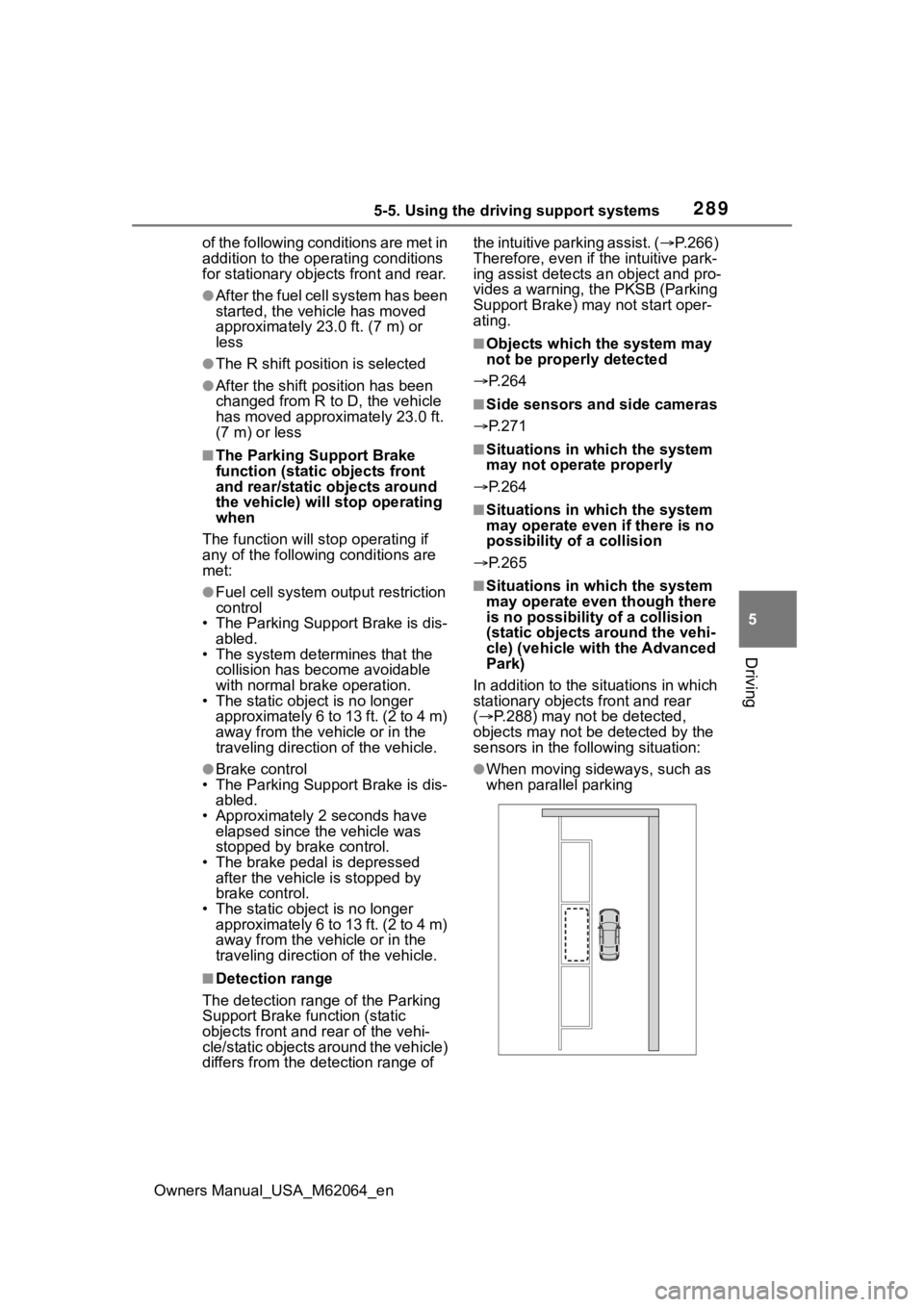
2895-5. Using the driving support systems
Owners Manual_USA_M62064_en
5
Driving
of the following conditions are met in
addition to the operating conditions
for stationary objects front and rear.
●After the fuel cell system has been
started, the vehicle has moved
approximately 23.0 ft. (7 m) or
less
●The R shift position is selected
●After the shift position has been
changed from R to D, the vehicle
has moved approximately 23.0 ft.
(7 m) or less
■The Parking Support Brake
function (static objects front
and rear/static objects around
the vehicle) will stop operating
when
The function will st op operating if
any of the following conditions are
met:
●Fuel cell system output restriction
control
• The Parking Support Brake is dis-
abled.
• The system determines that the collision has beco me avoidable
with normal brake operation.
• The static object is no longer approximately 6 to 13 ft. (2 to 4 m)
away from the vehicle or in the
traveling directi on of the vehicle.
●Brake control
• The Parking Support Brake is dis- abled.
• Approximately 2 seconds have elapsed since the vehicle was
stopped by brake control.
• The brake pedal is depressed after the vehicle is stopped by
brake control.
• The static object is no longer approximately 6 to 13 ft. (2 to 4 m)
away from the vehicle or in the
traveling directi on of the vehicle.
■Detection range
The detection range of the Parking
Support Brake function (static
objects front and r ear of the vehi-
cle/static objects around the vehicle)
differs from the detection range of the intuitive parking assist. (
P.266)
Therefore, even if the intuitive park-
ing assist detects an object and pro-
vides a warning, the PKSB (Parking
Support Brake) may not start oper-
ating.
■Objects which the system may
not be properly detected
P.264
■Side sensors and side cameras
P.271
■Situations in which the system
may not operate properly
P.264
■Situations in which the system
may operate even if there is no
possibility of a collision
P.265
■Situations in which the system
may operate even though there
is no possibility of a collision
(static objects around the vehi-
cle) (vehicle with the Advanced
Park)
In addition to the situations in which
stationary objects front and rear
( P.288) may not be detected,
objects may not be detected by the
sensors in the fo llowing situation:
●When moving sideways, such as
when parallel parking
Page 290 of 572
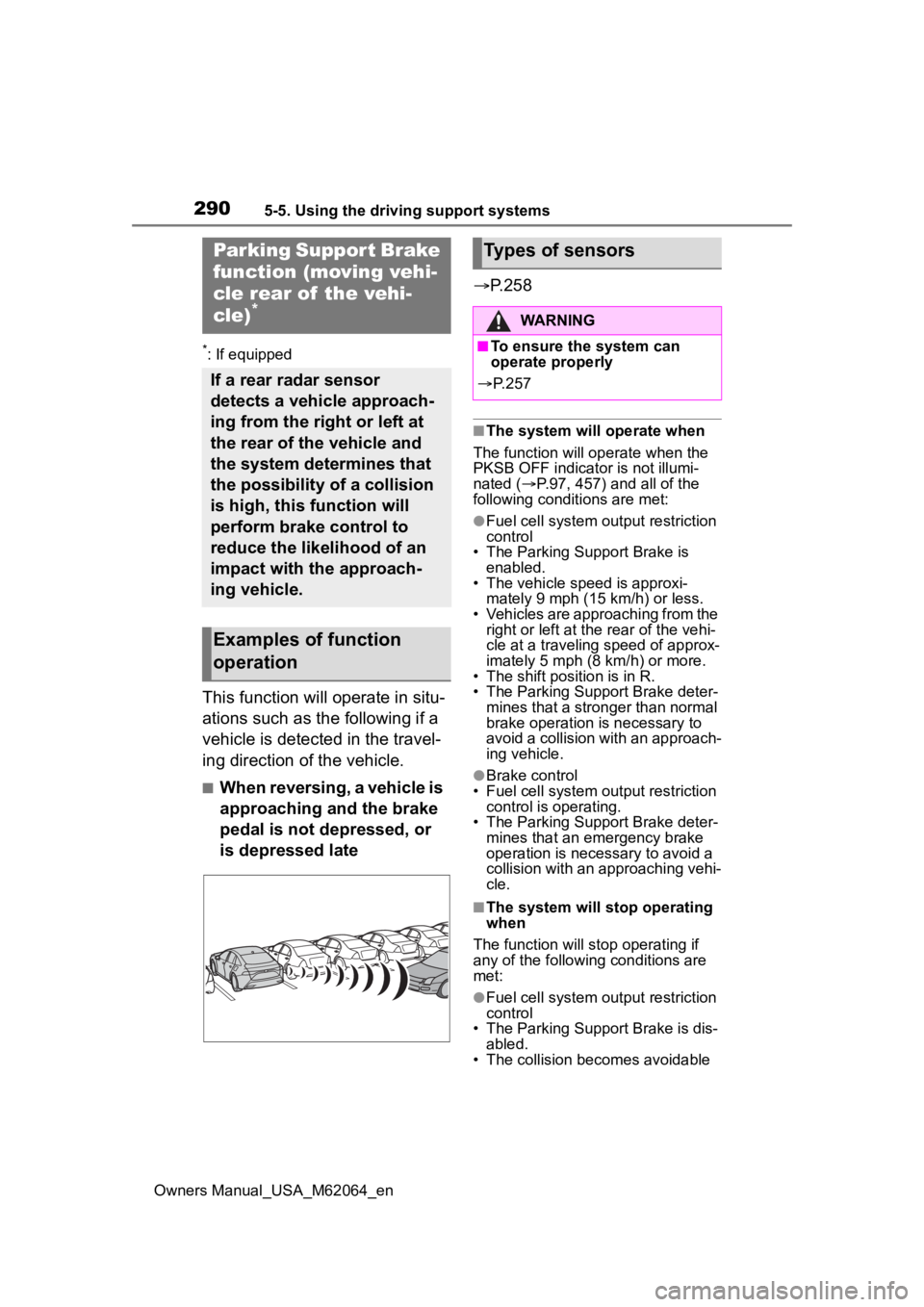
2905-5. Using the driving support systems
Owners Manual_USA_M62064_en
*: If equipped
This function will operate in situ-
ations such as the following if a
vehicle is detected in the travel-
ing direction of the vehicle.
■When reversing, a vehicle is
approaching and the brake
pedal is not depressed, or
is depressed late
P.258
■The system will operate when
The function will op erate when the
PKSB OFF indicator is not illumi-
nated ( P.97, 457) and all of the
following conditi ons are met:
●Fuel cell system output restriction
control
• The Parking Support Brake is enabled.
• The vehicle speed is approxi- mately 9 mph (15 km/h) or less.
• Vehicles are approaching from the
right or left at the rear of the vehi-
cle at a traveling speed of approx-
imately 5 mph (8 km/h) or more.
• The shift position is in R.
• The Parking Support Brake deter- mines that a stronger than normal
brake operation is necessary to
avoid a collision with an approach-
ing vehicle.
●Brake control
• Fuel cell system output restriction
control is operating.
• The Parking Support Brake deter- mines that an emergency brake
operation is necessary to avoid a
collision with an approaching vehi-
cle.
■The system will stop operating
when
The function will stop operating if
any of the following conditions are
met:
●Fuel cell system output restriction
control
• The Parking Support Brake is dis-
abled.
• The collision becomes avoidable
Parking Suppor t Brake
function (moving vehi-
cle rear of the vehi-
cle)
*
If a rear radar sensor
detects a vehicle approach-
ing from the right or left at
the rear of the vehicle and
the system determines that
the possibility of a collision
is high, this function will
perform brake control to
reduce the likelihood of an
impact with the approach-
ing vehicle.
Examples of function
operation
Types of sensors
WARNING
■To ensure the system can
operate properly
P. 2 5 7
Page 297 of 572
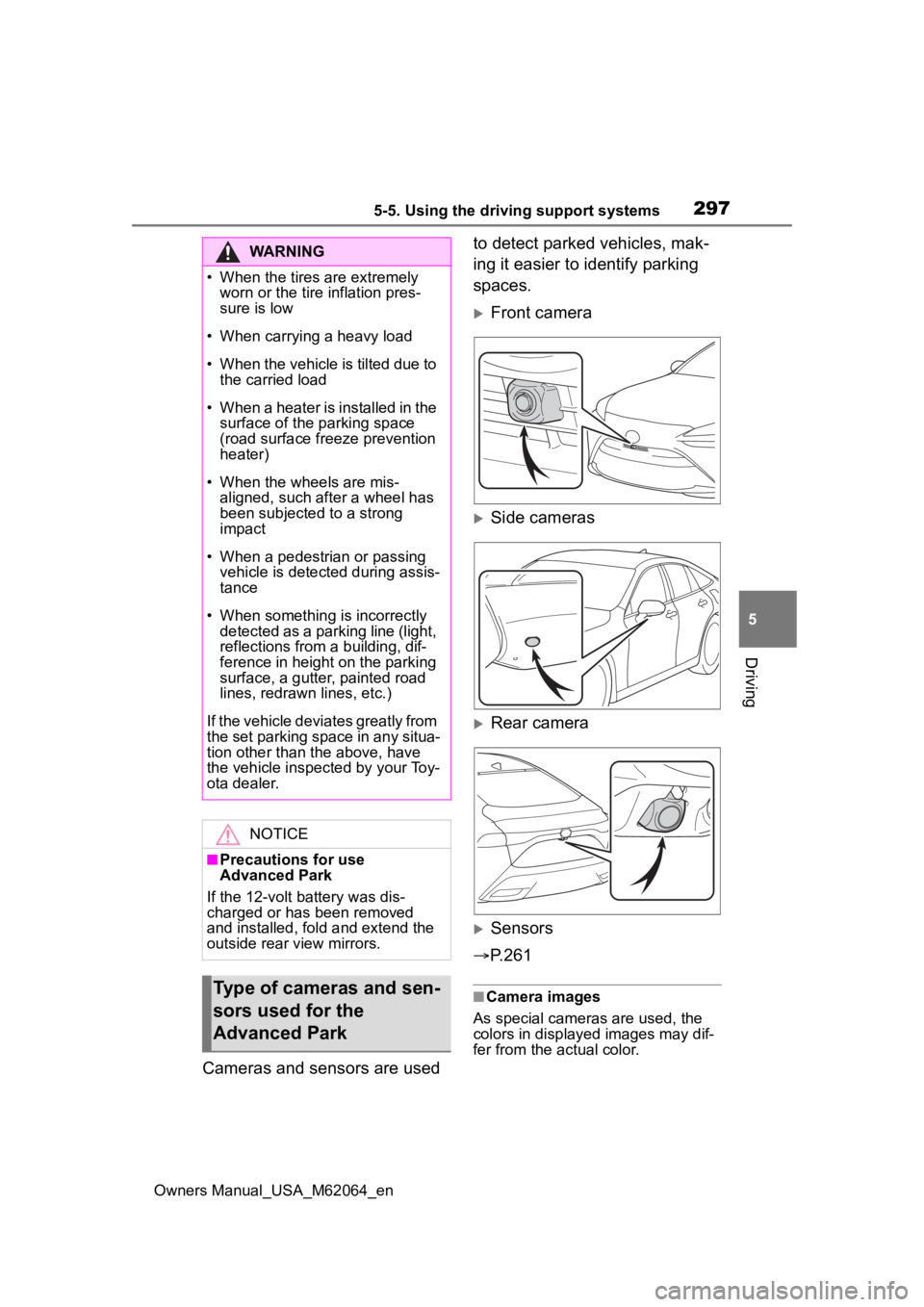
2975-5. Using the driving support systems
Owners Manual_USA_M62064_en
5
Driving
Cameras and sensors are used to detect parked vehicles, mak-
ing it easier to identify parking
spaces.
Front camera
Side cameras
Rear camera
Sensors
P.261
■Camera images
As special cameras are used, the
colors in displaye d images may dif-
fer from the actual color.
WARNING
�
Page 298 of 572

2985-5. Using the driving support systems
Owners Manual_USA_M62064_en
■Precautions for use
For details on the following, refer to
“Panoramic view monitor” of “Pan-
oramic view monitor functions” in
the “MULTIMEDIA OWNER’S MAN-
UAL”.
●Displayable range of the screens
●Cameras
●Differences between displayed
images and the actual road
●Differences between displayed
images and the actual objects
■Detection range of the cameras
and sensors
●If a parked vehicle is behind the
target parking space and the dis-
tance between it a nd the vehicle
becomes far, it may no longer be
able to be detected. Depending on
shape or conditi on of a parked
vehicle, the detection range may
become short or the vehicle may
not be detected.
●Objects other than parked vehi-
cles, such as columns, walls, etc.,
may not be detect ed. Also, if they
are detected, they may cause the
target parking space to be mis-
aligned.
■Situations in which parking
space lines may not be recog-
nized properly
●In situations such as the following,
parking space lines on the road
surface may not be detected:
• When the parking space does not
use lines (parking space boundar-
ies are marked with rope, blocks,
etc.)
• When the parking space lines are
faded or dirty, making them
unclear
• When the road surface is bright,
such as concrete, and the contrast
between it and t he white parking
space lines is small
• When the parking space lines are
any color other than yellow or
white
• When the area surrounding the parking space is dark, such as at
night, in an underground parking
lot, parking garage, etc.
• When it is raining or has rained and the road surface is wet and
reflective or there are puddles
• When the sun is shining directly into a camera, such as in the early
morning or evening
• When the parking space is cov- ered with snow or de-icing agent
• When there marks from repairs or
other marks on the road surface,
or there is a traffic bollard, or other
object on the road surface
• When the color or brightness of the road surface is uneven
• When a camera has been
splashed by hot or cold water and
the lens has fogged up
• When the appearance of the park-
ing space is affected by the
shadow of the vehicle or trees
• When a camera lens is dirty or
covered with wa ter droplets
●In situations such as the following,
the target parking space may not
be recognized correctly:
• When there marks from repairs or
other marks on the road surface,
or there is a parking block, traffic
bollard, or other object on the road
surface
• When it is raining or has rained and the road surface is wet and
reflective or there are puddles
• When the area around the vehicle is dark or backlit
• When the color or brightness of the road surface is uneven
• When the parking space is on a
slope
• When there are diagonal lines (access aisle) nea r the parking
space
• When the appearance of the park- ing space is affected by the
shadow of a parked vehicle (such
as shadows from the grille, side
step, etc.)
• When accessories which obstruct
the view of the camera are
installed
• When the parking space lines are
Page 299 of 572
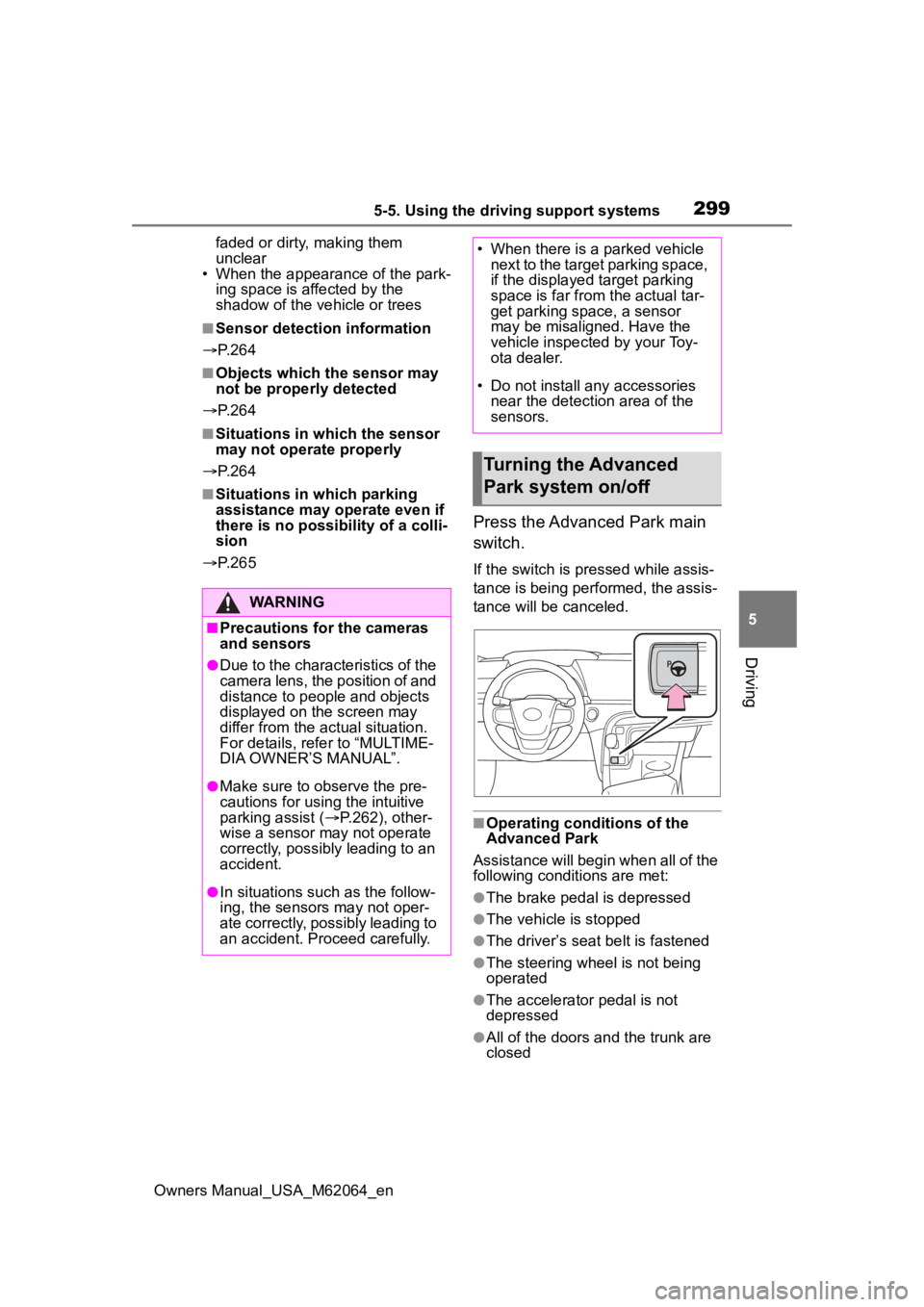
2995-5. Using the driving support systems
Owners Manual_USA_M62064_en
5
Driving
faded or dirty, making them
unclear
• When the appeara nce of the park-
ing space is affected by the
shadow of the vehicle or trees
■Sensor detection information
P. 2 6 4
■Objects which the sensor may
not be properly detected
P. 2 6 4
■Situations in which the sensor
may not operate properly
P. 2 6 4
■Situations in which parking
assistance may operate even if
there is no possibility of a colli-
sion
P. 2 6 5
Press the Advanced Park main
switch.
If the switch is pressed while assis-
tance is being performed, the assis-
tance will be canceled.
■Operating conditions of the
Advanced Park
Assistance will begin when all of the
following conditi ons are met:
●The brake pedal is depressed
●The vehicle is stopped
●The driver’s seat belt is fastened
●The steering wheel is not being
operated
●The accelerator pedal is not
depressed
●All of the doors a nd the trunk are
closed
WARNING
■Precautions for the cameras
and sensors
●Due to the characteristics of the
camera lens, the position of and
distance to people and objects
displayed on the screen may
differ from the actual situation.
For details, refer to “MULTIME-
DIA OWNER’S MANUAL”.
●Make sure to observe the pre-
cautions for using the intuitive
parking assist ( P.262), other-
wise a sensor ma y not operate
correctly, possibly leading to an
accident.
●In situations such as the follow-
ing, the sensors may not oper-
ate correctly, possibly leading to
an accident. Proceed carefully.
• When there is a parked vehicle next to the target parking space,
if the displayed target parking
space is far from the actual tar-
get parking space, a sensor
may be misaligned. Have the
vehicle inspected by your Toy-
ota dealer.
• Do not install any accessories near the detection area of the
sensors.
Turning the Advanced
Park system on/off
Page 393 of 572
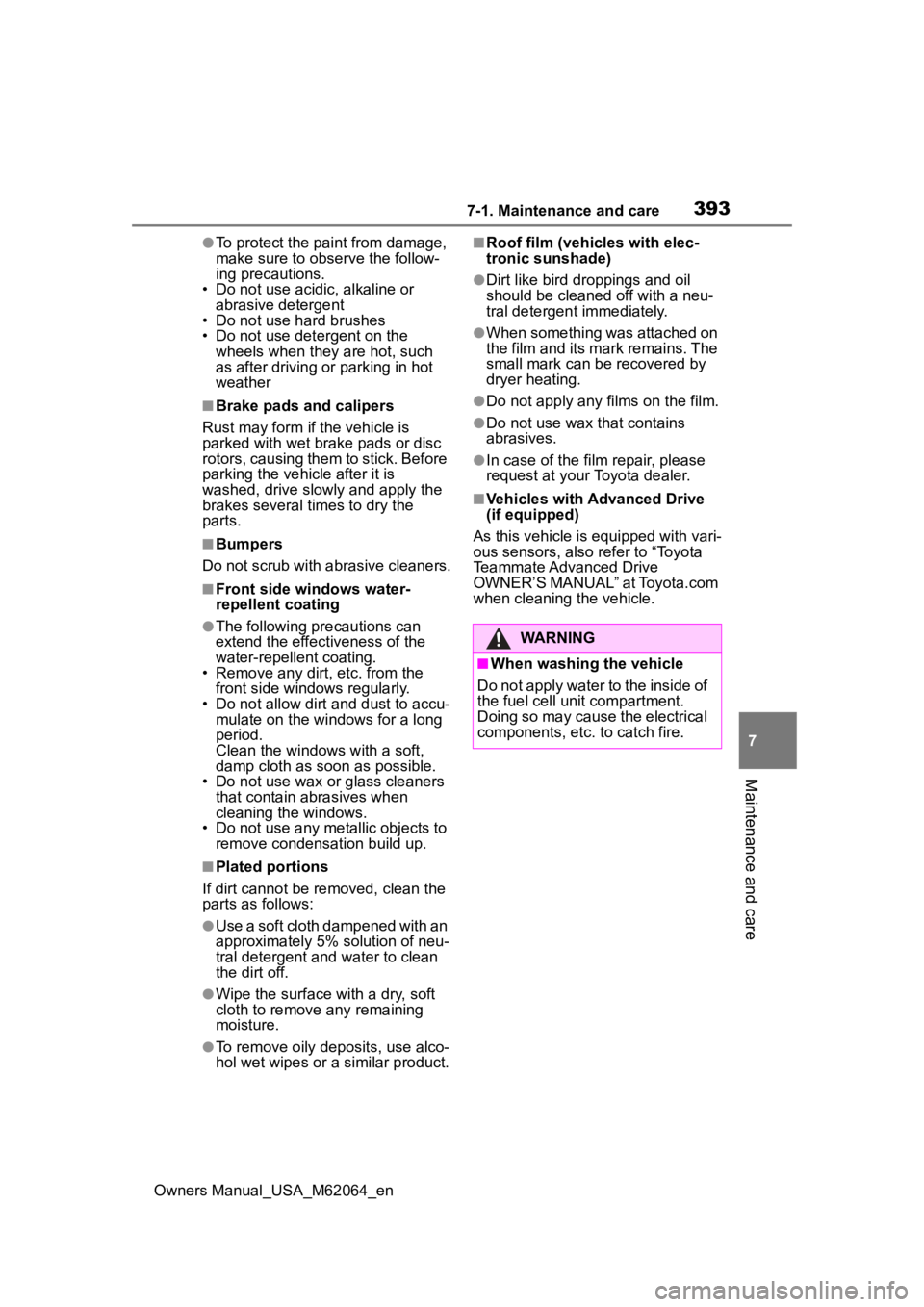
3937-1. Maintenance and care
Owners Manual_USA_M62064_en
7
Maintenance and care
●To protect the paint from damage,
make sure to obs erve the follow-
ing precautions.
• Do not use acidi c, alkaline or
abrasive detergent
• Do not use hard brushes
• Do not use det ergent on the
wheels when they are hot, such
as after driving or parking in hot
weather
■Brake pads and calipers
Rust may form if the vehicle is
parked with wet brake pads or disc
rotors, causing them to stick. Before
parking the vehicle after it is
washed, drive slow ly and apply the
brakes several times to dry the
parts.
■Bumpers
Do not scrub with abrasive cleaners.
■Front side windows water-
repellent coating
●The following precautions can
extend the effectiveness of the
water-repellent coating.
• Remove any dirt, etc. from the front side windows regularly.
• Do not allow dirt and dust to accu- mulate on the windows for a long
period.
Clean the windows with a soft,
damp cloth as soon as possible.
• Do not use wax or glass cleaners
that contain abrasives when
cleaning the windows.
• Do not use any metallic objects to
remove condensation build up.
■Plated portions
If dirt cannot be removed, clean the
parts as follows:
●Use a soft cloth dampened with an
approximately 5% solution of neu-
tral detergent and water to clean
the dirt off.
●Wipe the surface with a dry, soft
cloth to remove any remaining
moisture.
●To remove oily deposits, use alco-
hol wet wipes or a similar product.
■Roof film (vehicles with elec-
tronic sunshade)
●Dirt like bird droppings and oil
should be cleaned off with a neu-
tral detergent immediately.
●When something was attached on
the film and its mark remains. The
small mark can be recovered by
dryer heating.
●Do not apply any films on the film.
●Do not use wax that contains
abrasives.
●In case of the film repair, please
request at your Toyota dealer.
■Vehicles with Advanced Drive
(if equipped)
As this vehicle is equipped with vari-
ous sensors, also refer to “Toyota
Teammate Advanced Drive
OWNER’S MANUAL” at Toyota.com
when cleaning the vehicle.
WARNING
■When washing the vehicle
Do not apply water to the inside of
the fuel cell unit compartment.
Doing so may cause the electrical
components, etc . to catch fire.
Page 551 of 572

Owners Manual_USA_M62064_en
Alphabetical Index551
P
Panic mode ............................. 125
Parking assist sensors (intuitive parking assist) ...................... 261
Parking brake ......................... 191 Brake system warning light .. 454
Operation ............................. 191
Parking brake engaged warning buzzer ................................ 193
Warning light ........................ 459
Warning message ................ 193
Parking lights Light switch .......................... 198
Replacing light bulbs ............ 443
Parking Support Brake (PKSB) ............................................... 281Enabling/disabling the system ........................................... 283
Parking Support Brake function (moving vehicle rear of the
vehicle) ............................... 290
Parking Support Brake function (pedestrians rear of the vehicle)........................................... 291
Parking Support Brake function (static objects around of the
vehicle) ............................... 286
Parking Support Brake function (static objects front and rear of
the vehicle) ......................... 286
Warning lights....................... 457
Warning message ................ 286
PCS (Pre-Collision System)... 219 Enabling/disabling the system........................................... 222
Function ............................... 219
Warning light ........................ 456
Personal lights ....................... 355 PKSB (Parking Support Brake)
...............................................281Enabling/disabling the system ...........................................283
Parking Support Brake function (moving vehicle rear of the
vehicle) ...............................290
Parking Support Brake function (pedestrians rear of the vehicle)...........................................291
Parking Support Brake function (static objects around of the
vehicle) ...............................286
Parking Support Brake function (static objects front and rear of
the vehicle) .........................286
Warning lights .......................457
Warning message.................286
Pop Up Hood .............................43
Power control unit ....................81
Power control unit coolant Preparing and checking before winter ..................................327
Power easy access system ...142
Power outlet ............372, 373, 374
Power steering (Electric power steering system) ...................322Warning light.........................456
Power switch...........................180 Auto power off fun ction .........184
Changing the power switch modes.................................183
If your vehicle has to be stopped in an emergency .................446
Power windows Door lock linked window opera-tion......................................163
Jam protection function ........162
Operation..............................162
Window lock switch ..............164